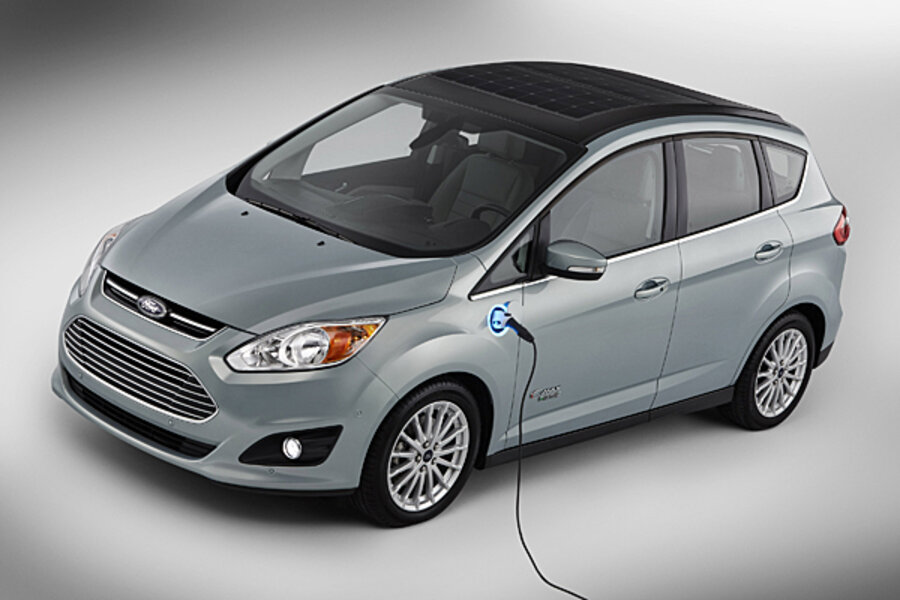C-Max Solar Energi: Ford goes off-grid with new solar car
Loading...
Still no flying cars yet, but we're getting closer to ones that run on sun.
The world's fifth-largest automaker debuted a plug-in hybrid concept car Tuesday that combines a conventional gasoline engine with rooftop solar panels and a large concentrating lens to charge its battery.
Don't throw out your plug-in charger quite yet. Ford's C-Max Solar Energi is very much in the development stage, and there are legitimate questions of cost, safety, and energy output. But as a technological demonstration, the C-Max Solar Energi hints at an automotive future that bypasses both gas-station networks and electrical grids – cars powered directly and exclusively by domestic, renewable energy.
"For a developed country like the US, not all grids are the same in terms of renewable content," Mike Tinskey, director of vehicle electrification and infrastructure at Ford, says in a telephone interview. "You definitely get 100 percent renewables from this configuration."
Automakers like Toyota and Audi have used solar panels to power secondary equipment like climate control, but Ford is the first major automaker to leverage the power of the sun to physically move a consumer car from point A to point B. The trick has long been cramming enough solar panels on the roof of a car to match the power of the traditional, energy-dense gasoline that fuels most cars on the road today.
"You don’t have a lot to work with when you’re talking about the roof of a car versus the roof of a house," says Karl Brauer, senior director of insights for Kelley Blue Book, in a telephone interview, "and the more energy-dense you make the solar cell, the more expensive it’s going to be."
The C-Max Solar Energi uses 16 square feet of state-of-the-art, high-efficiency solar panels designed by SunPower, a solar energy firm in San Jose, Calif., but it still takes about a week of average sunlight to fully charge the battery. That's not exactly ideal, so Ford collaborated with the Georgia Institute of Technology to develop a special solar concentrating lens to reduce the charging time.
The oversize Fresnel lens – like those used in lighthouses – rests on a stationary canopy above the car when parked, funneling sunlight onto the photovoltaic cells. To maximize the effect, the car is programmed to automatically inch backward or forward throughout the day, tracking the sun as it moves through the sky. That eliminates the need for wiring expensive electric charging infrastructure. With the lens, Ford estimates it takes the car about six or seven hours to charge in an average US city's sunlight. It can also be plugged in like a conventional plug-in to charge at night or when there's not enough sun.
On a full charge, the C-Max Solar Energi will go 21 electric-only miles. That may not seem like a lot, but most trips for most drivers are quick trips to work or the grocery store. Ford estimates the electric range could cover 75 percent of all trips made by an average driver. For all other trips, the car has a gas engine that extends its range up to 620 miles.
"Essentially, they are electric vehicles, and then they turn into hybrids when you want to go further than 21 miles," Mr. Tinskey says.
Electric carmakers have a hard enough time getting drivers to embrace charging stations, so it's hard to imagine US consumers eager to put a giant magnifying glass in their backyard or an office parking lot. Ford also has to ensure there's no possibility of a passerby accidentally wandering into the path of super-concentrated sunbeams.
Solar-powered cars are more attractive for communities without any access to an electrical grid, but there's still the cost issue. Ford hasn't put a price tag on the C-Max Solar Energi yet, but it's safe to say that the state-of-the-art, super-efficient solar panels on the roof add a significant premium.
"It’s a great idea, and probably has some limited applications," says John O'dell, senior editor at Edmunds.com, in a telephone interview. "But I don’t see it as a sweeping, new, big idea in how we power our vehicles."
For now, petroleum dominates transportation, the second-most energy intensive sector in the US, behind electric power. In 2012, petroleum made up 93 percent of the 26.6 quadrillion BTU of energy consumed by US vehicles.
As solar continues to get cheaper and more efficient, that could change. They may not power every part of a car all of the time, but rooftop photovoltaics might one day come standard with your new car purchase.
"Integrated solar panels could be another circumstance that in 10 or 20 years you’d wonder why anyone would build a car without solar panels on the roof," Mr. Brauer says.
The Ford C-Max Solar Energi debuted Tuesday in Las Vegas at the 2014 International CES, a consumer electronics show.








